Carl Philipp Gottfried von Clausewitz is often misquoted as saying, “No operational plan extends with high certainty beyond the first encounter with the main enemy force.” In fact, it was not von Clausewitz, but rather Helmuth Karl Bernhard Graf von Moltke who said that, even though it’s a fair restatement of the battle philosophy of von Clausewitz. What does this have to do with hiking?
I have a plan. The plan is to cover 271.4 miles in 29 days. But my return flight home actually leaves 33 days after I step off in Harpers Ferry, WV. Experience has taught me to plan for the unexpected. Delays, setbacks, distractions, coincidences, and opportunities will change the plan, almost certainly from the start. I wouldn’t be surprised if I got back a week later than planned, or didn’t finish at all. In any case, I’ve resigned myself to the fact that I’m not completely in control of this hike. The trail will teach me what I need to know, one way or the other.
Which brings me to the point of this post. Dealing with the unknown, i.e., being comfortable in an uncertain situation, is a trait known as “tolerance of ambiguity.” Project managers are good at assessing ambiguity, usually phrased as complexity and uncertainty. In fact, any project manager worth her salt knows that the first step to controlling uncertainty is to acknowledge it. Then a “band” of uncertainty is applied, usually with statistical tools. By defining the boundaries, PMs can gain some level of comfort.
It turns out that TOA is a key characteristic of many leaders. It is negatively correlated with neuroticism and positively correlated with openness to new ideas. As I’ve gone through my career, I’ve coached many managers to examine their level of comfort with ambiguity. When they reply that uncertainly makes them anxious (not usually in those words), I point out that ambiguity will exist regardless of their feelings. But if they want to feel better, be prepared.
